If you were to walk into my garden any summer you'd see every one of these things at work. These are the tips that usually end up being the answer to any of the gardening questions I get from friends and family.
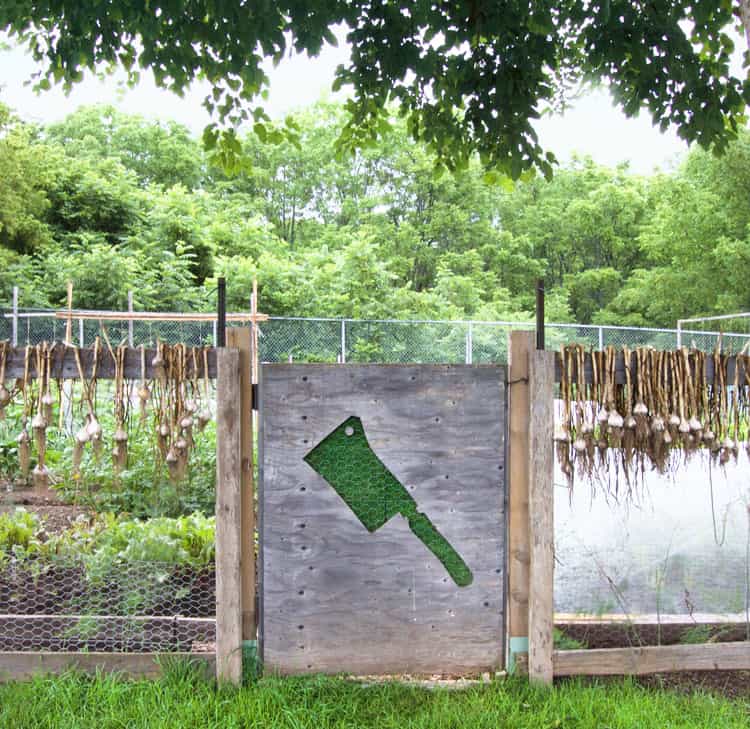
Why is garlic hanging on the fence? To introduce you to your first tip. There are also tips within the tips which of course makes this much more exciting.
This is a big post with a lot of information but it's all easy to remember if you just write it all down 5 times in a row and then memorize it.
OR you can download the quick tip sheet with only the essential information. That free download opportunity is coming up for you about halfway down the post.
An Overview of My Garden
In case you're new around here.
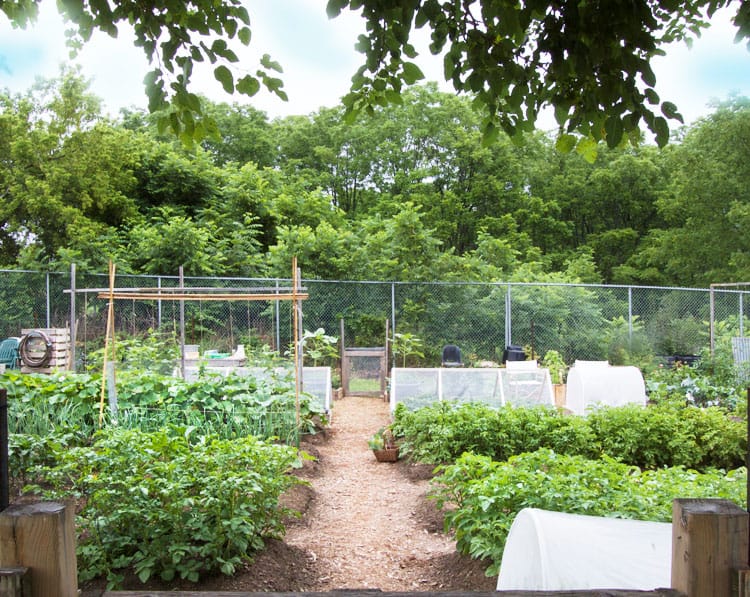
My garden is 40' x 40' and in classic rows mainly because I actually prefer the look and feeling of long rows in a garden. It feels nostalgic to me.
There is a central path that runs from the front gate to the back gate. Off of either side of the path are 16' rows each planted with a variety of things.

I used raised soil beds without any wood framing. Wood sided raised beds looks nice, holds soil well and prevents weeds on the sides of the beds. But they are expensive and constantly need to be replaced.
Here we go ... the tips I didn't know, but now do and therefore want to share with you.
Table of Contents
Tip #1 - Curing Garlic & Onions
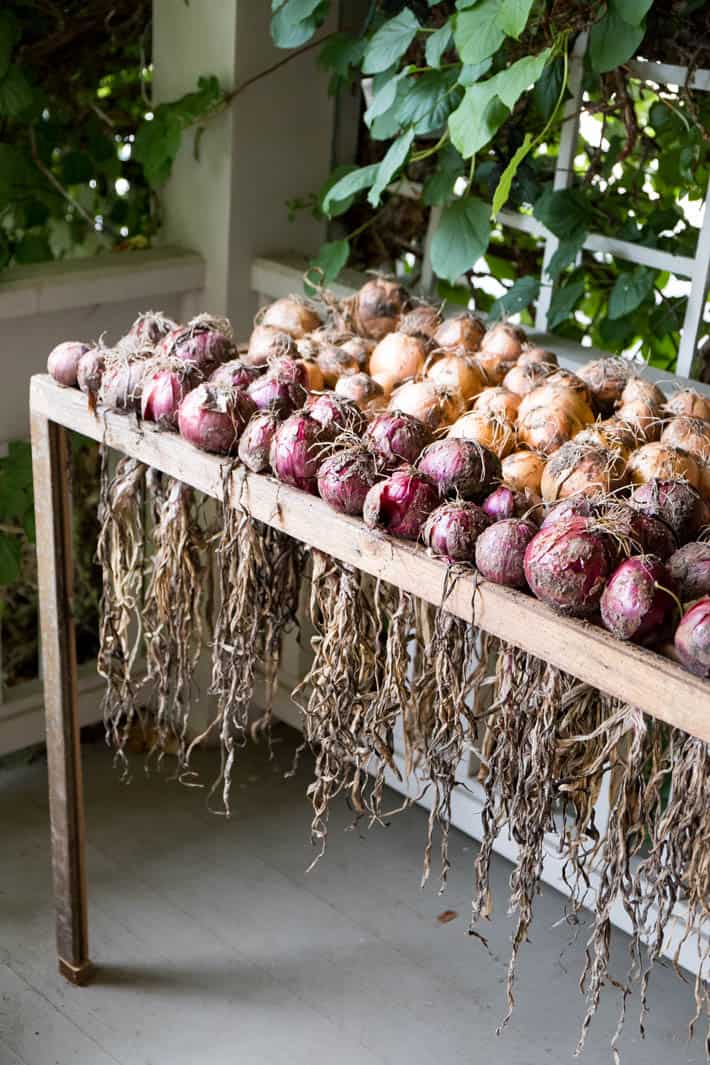
Garlic and onions needs to be cured for 2 weeks outdoors in the shade. Doing this lets the outer skins slowly dry out while the inside retains all of its moisture. Curing extends garlic and onion shelf life so they'll store longer.
Tip #2 - No dig gardening
I've been no dig gardening since 2017. I mean, you know, for the most part. There's only one Charles Dowding.
No dig gardening means you do not till, poke, prod, lift or disturb the soil. This benefits the top layer of soil and all the microbes, worms and other crawlies that are keeping your soil aerated, fed, and healthy.
Each year to feed the soil you add a few inches of compost on top of your beds and plant directly into that.
A word about weeds and no dig
No dig also helps eliminate weeds because if you aren't moving and disturbing the soil, you aren't exposing any of the thousands of weed seeds that are in your soil to sunlight and rain.
Every time you turn over a shovelful of soil, you're exposing all the weed seeds that were deep in the soil to the top of the soil. These weed seeds had no intention of sprouting until you flipped the soil and put them in a front row seat to rain and sun.
ALTERNATIVE - Short on compost? Instead of covering your beds with a 2-3" layer of compost, dig a hole for your seedlings and fill the hole with compost for planting in.
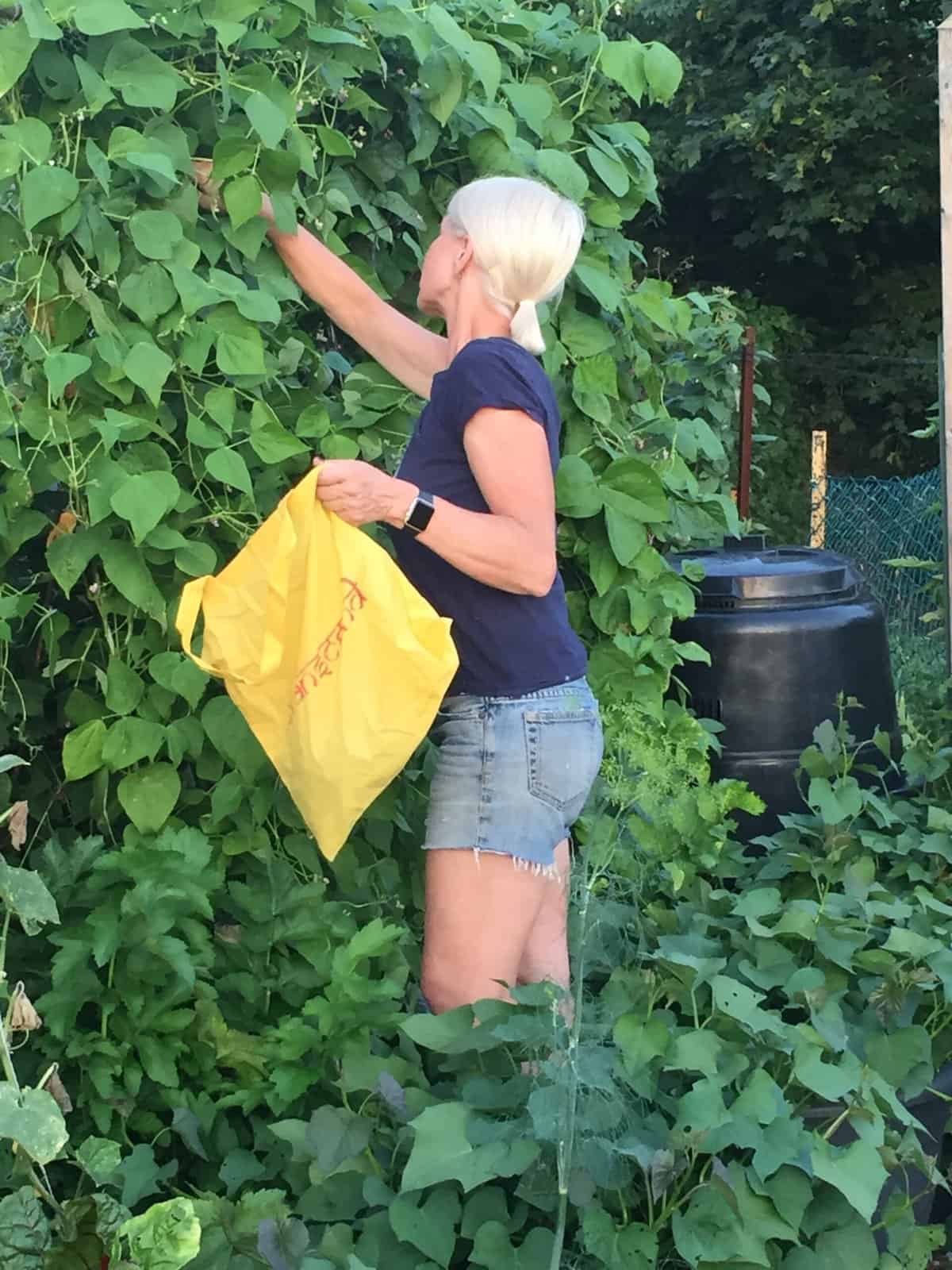
The bean trellis! How do you do it?
Tip #3 - Trellising
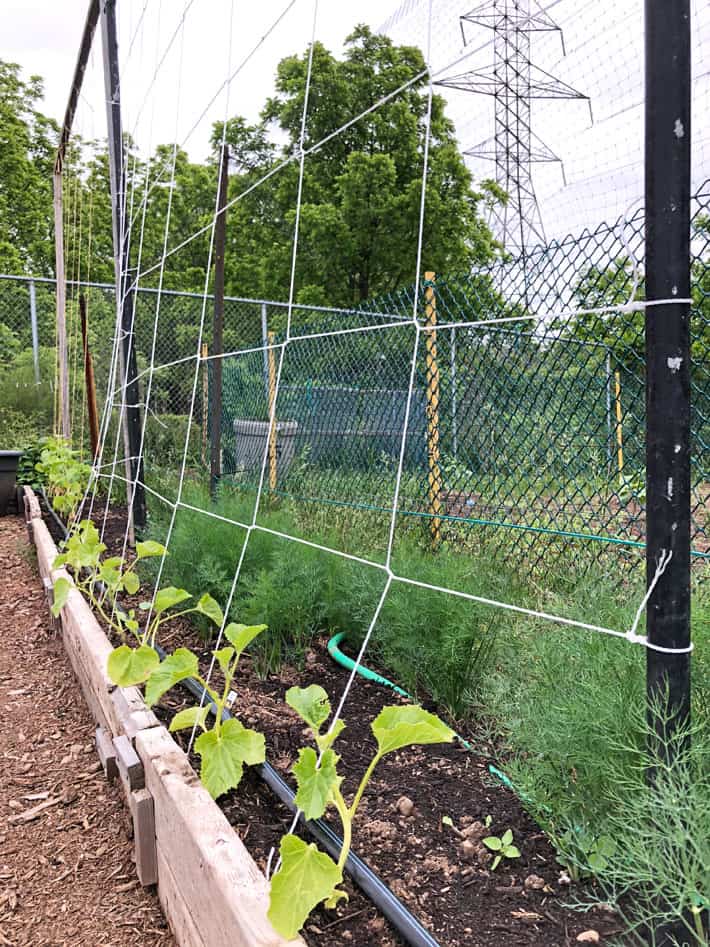
To make a bean (or cucumber) trellis that'll last a year or two buy some wood 1 x 1's. Either hammer them into the soil or dig a 1' deep hole and place a length of wood into each hole.
Add another piece of wood lengthwise across the top of your 2 staked 1x1s and attach it by screwing it in. You can either run string back and forth between the wood to create a trellis or use plastic netting or chicken wire for the plants to grow on.
You can also use metal T Posts which will last for years and years and years and years and years until you don't even like beans anymore.
Tip #4 - Weed suppression
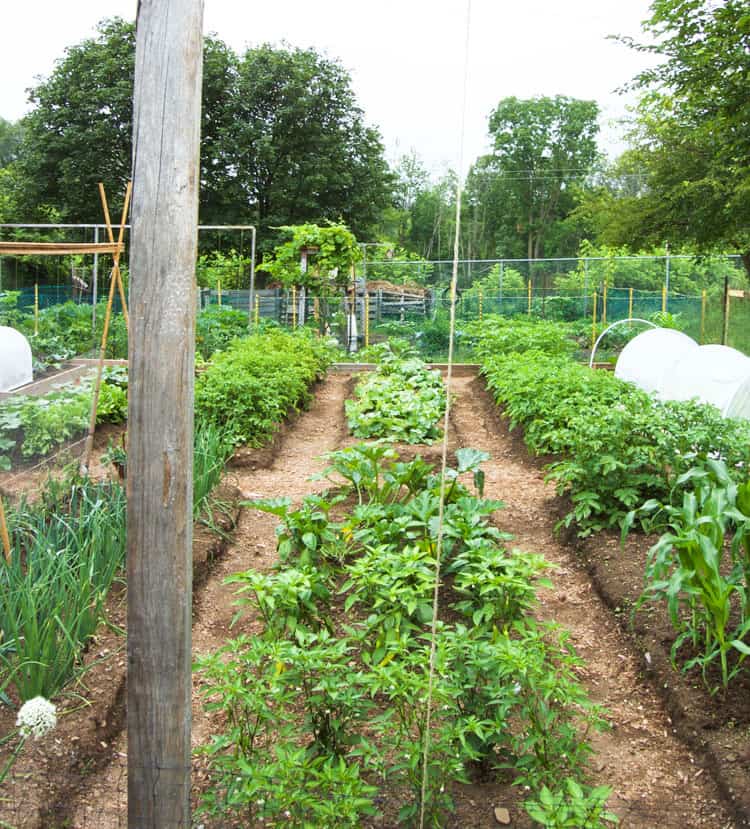
To stop weeds in either beds or paths lay down a layer of newspaper then top it with 2-3" of natural, cedar mulch. The newspaper eventually decomposes at which point you just need to top up your mulch every year.
Alternative - You can use professional grade landscape fabric on paths to control weeds. It works well but is slippery when wet and doesn't look as pretty as mulch. BUT it lasts longer and doesn't need to be replaced for many, many years.
Tip #5 - Corn
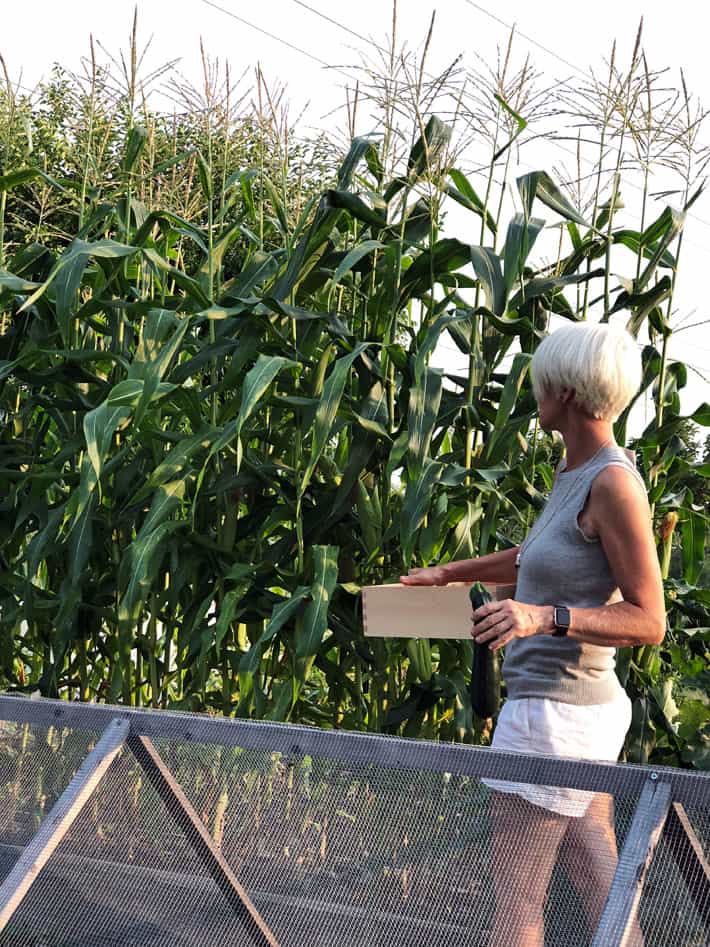
Don't grow corn in a single row. Each corn stalk pollinates those around it and it does a much better job of that if it's grown in a clump.
A square bed of corn will be way more productive than a long row.
Also, don't grow two varieties of corn near each other (especially ornamental and edible) because they'll cross pollinate and you can end up with some weird-ass corn.
Want just the essentials? Download the Quick-Tip Sheet for a glanceable version of all 20+ tips—perfect for printing and stapling to the shed wall.
Tip #6 - Carrot germination
You need plywood or wood boards. A more religious woman would use them to kneel on to pray to the Gods for carrot germination. I use them to *almost* guarantee carrot germination.
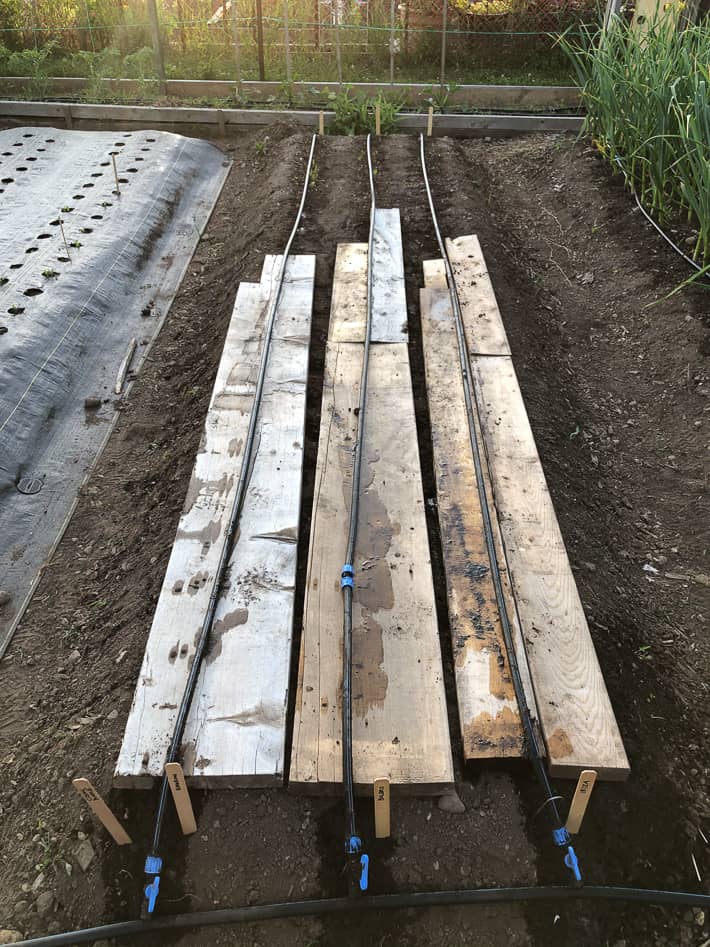
To get carrots to germinate, plant the seeds into watered soil and then cover them up for a week. Flat wood is your best option because it presses down and helps the seeds maintain contact with the soil but you can use burlap as well.
The wood or cloth helps keep the seeds damp and in darkness which they like.
Carrot seeds are temperamental.
Tip #7 - My favourite tip
Boxes, bags and baskets.
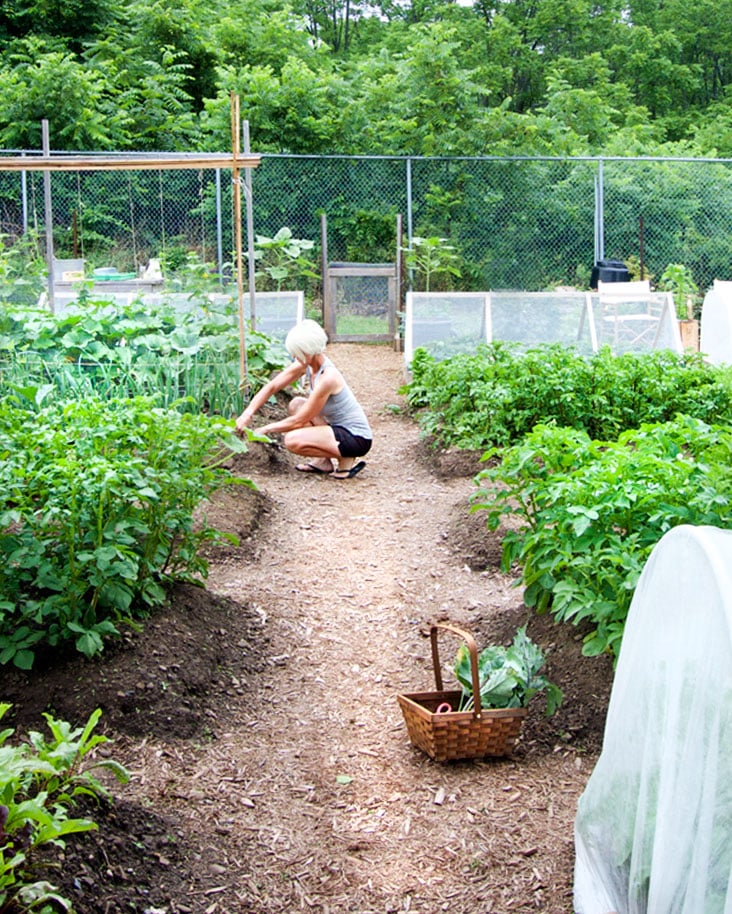
Keep bags or baskets for carrying vegetables RIGHT in your garden at all times.
ALWAYS keep something in your garden for putting vegetables in to take home, whether your home is 20 steps away or a 5 minute drive. How the hell do you think you're going to carry it all? And if you think you'll always remember to bring a bag or basket whenever you go into the garden you're wrong. We're not that smart.
Bonus harvesting tip: Don't wash your vegetables right away if you want them to store well. Brush the extra soil off of them and leave it at that. Wash them just before you're going to prepare them to eat.
Tip #8 - Row Cover

To keep crops clean use row cover.
You can either just "float" it right over the plants, holding the edges down with rocks or wood or you can make hoops out of flexible plumbing pipes.
To build a mini hoop house:
Drape row cover over the hoops and secure it to the ground using rocks, bricks, or strips of wood.
Hammer rods or bamboo sticks into the ground on both sides of the garden bed, spacing them about every 3 feet.
Slip flexible plastic tubing (from the hardware store) over each rod to form an arch. The rods must be slightly thinner than the inside of the tubing so the tubing can slide over and stay in place.
Or you can buy premade garden hoops in a variety of heights and widths.
Types of Row Cover
Generally I work with mesh insect netting or a medium weight row cover. The heavier the row cover, the less light can pass through it. That's good for protection from frost but not good for allowing enough lights to get to the plants to grow well.
Tip #9 - Potato hilling
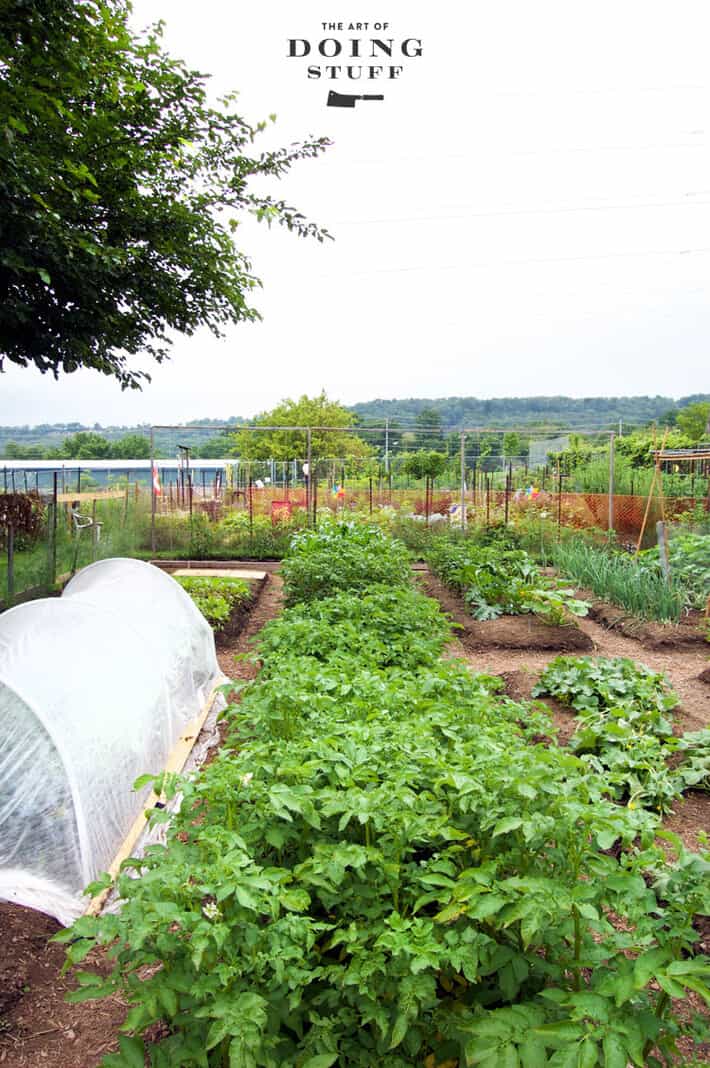
If you don't have it in you to hill your potatoes ... don't. I have never noticed any huge loss of potato production from not hilling.
Potato hilling is most necessary when you have planted your seed potatoes either on top of the soil or in the first few inches.
If you have planted deep (9-12") there's no huge advantage to hilling.
The other big hit in the garden with kids are the melons. You haven't experienced life if you haven't sat down in a garden and consumed a just picked Honeydew still warm from the sun.
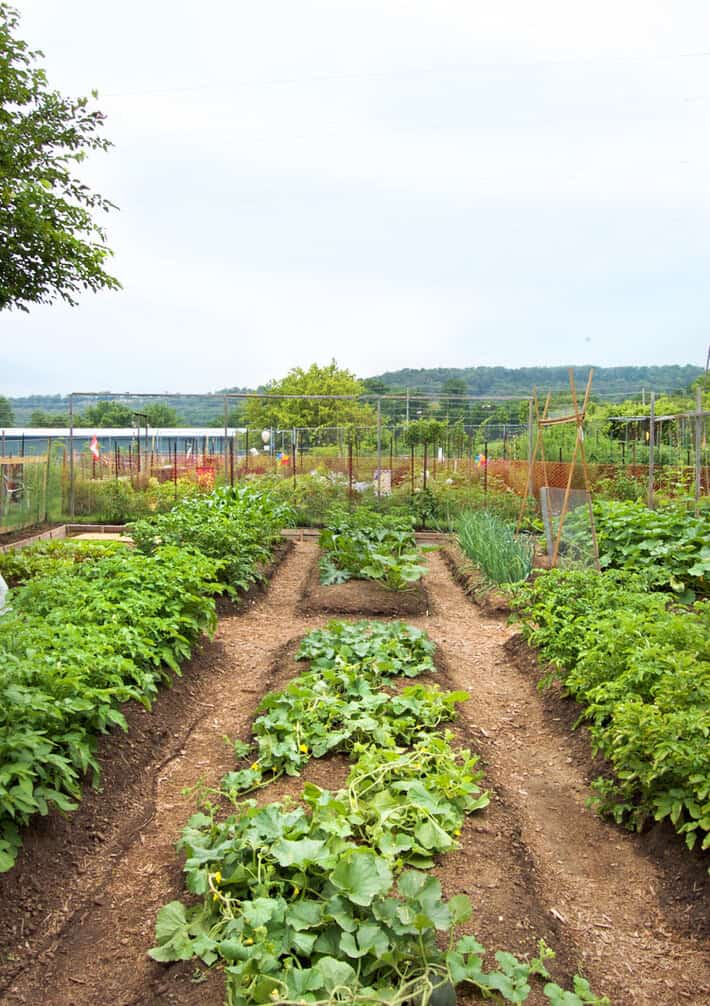
Tip #10 - Sweeter Melons
Don't water your melons as they're getting to the point of ripening. You'll just dilute them. Less water when ripening = sweeter melons.
Would you like to save this stuff?
The more melons ripening on the same vine the less sweet they'll be because they all have to share the sugars the vine leaves have produced.
If you have 2 or 3 melons of around the same size growing on the same plant pinch 2 of them off if you want a really sweet melon.
Tip #11 - Weeding habits
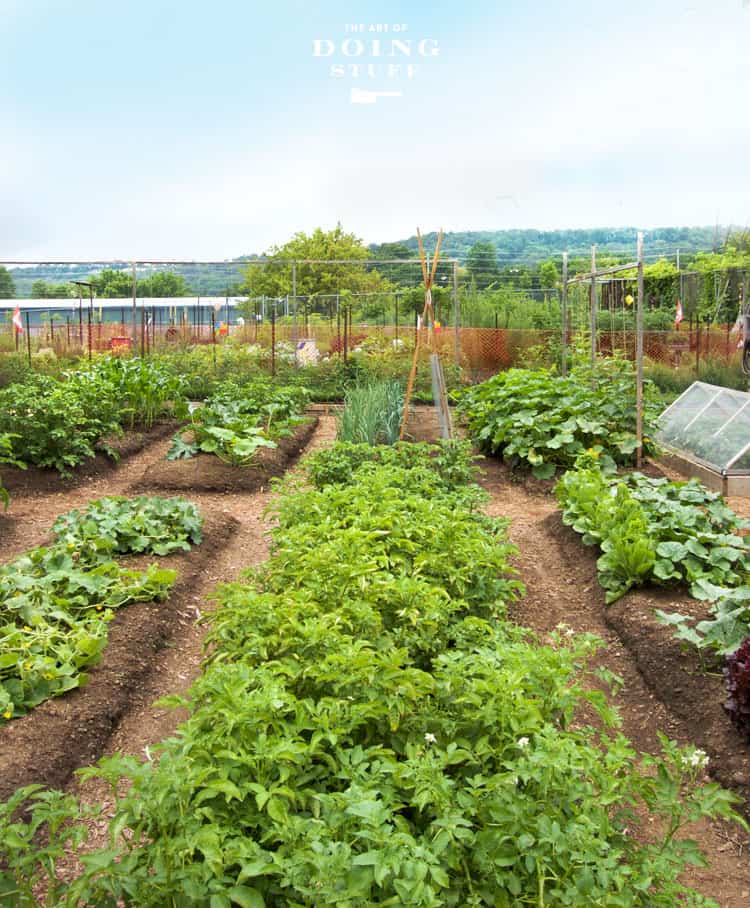
Every time you step foot in your garden pull some weeds. Make it a habit.
The more you weed the less weeds you'll have. Weeds flower and go to seed quicklyyyyy. THIS is the crucial point. If you don't pull the weeds before they go to flower and seed, those seeds will drop all over your soil and start the weed cycle again. It will never end.
If you take the time in the spring and especially for that first year to get rid of all the weeds as they appear and never let them go to seed you'll make every subsequent year more and more weed free.
Whenever I walk into my garden I keep my head down and just weed for 10 minutes. I don't even look around to see what has grown or if there's a giant pyramid of raccoons anywhere - I just weed.
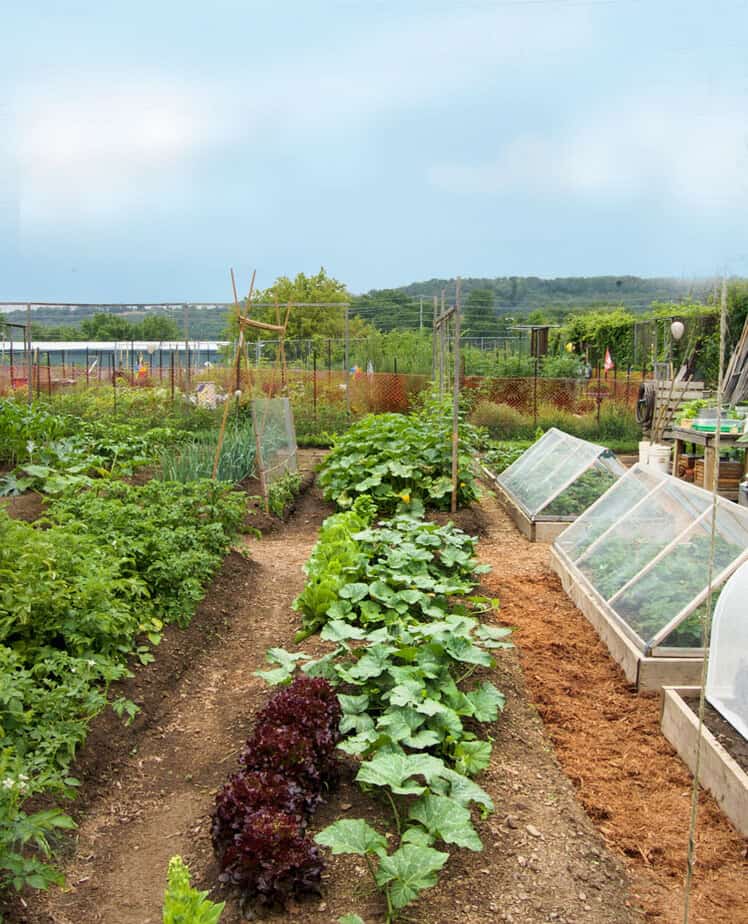
Tip #12 - Pumpkin leaf recipe
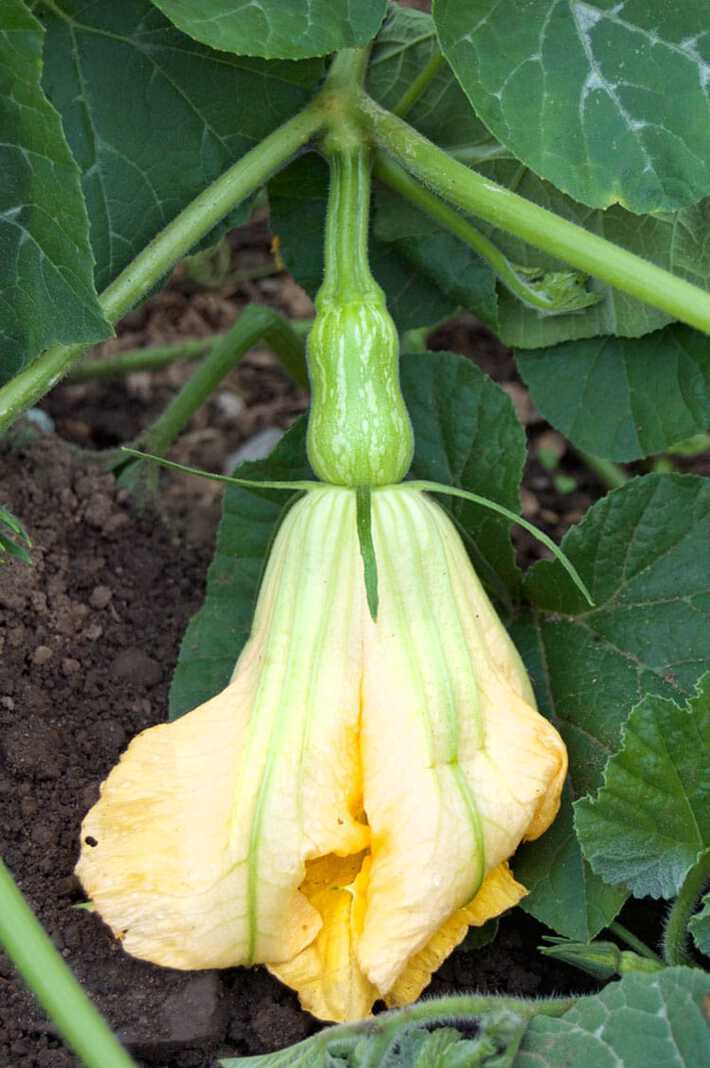
Pumpkin leaves are one of the many edible leaves we tend to just ignore. A lot of the weeds we pull are excellent for salad or as sauteed greens.
With pumpkin leaves only pick the smaller, more tender pumpkin leaves, boil them in water with some baking soda (to help soften them) for a couple of minutes, then sauté them with tomatoes and onions. The boiling also helps get rid of the prickles on the squash leaves and stem.
All pumpkin leaves are edible but the ones with the white veining are the ones my fellow gardener from Zimbabwe told me they eat.
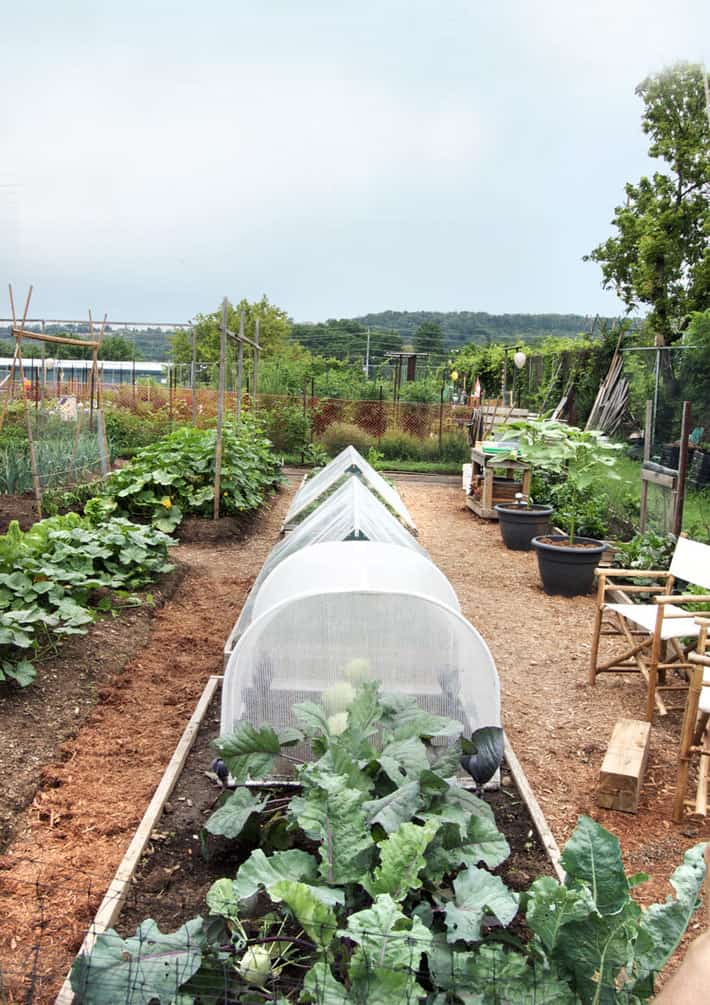
I think we need to take a break here so I can let you know I realize this is probably the least hysterical post I've ever written. But there's a lot of information to get through and my brain is focused on teaching. If I can muster up the energy I'll throw in a knock knock joke later on.
Tip #13 - Cabbage harvest
Cabbage will grow 2 or 3 more small heads after you harvest the initial large head. Just cut the cabbage off just above ground level instead of pulling up the whole plant. Within a couple of weeks it'll start growing a couple of new heads off of the base of the stalk which are a FAR more reasonable size for eating. They're perfect for roasting as a side dish.
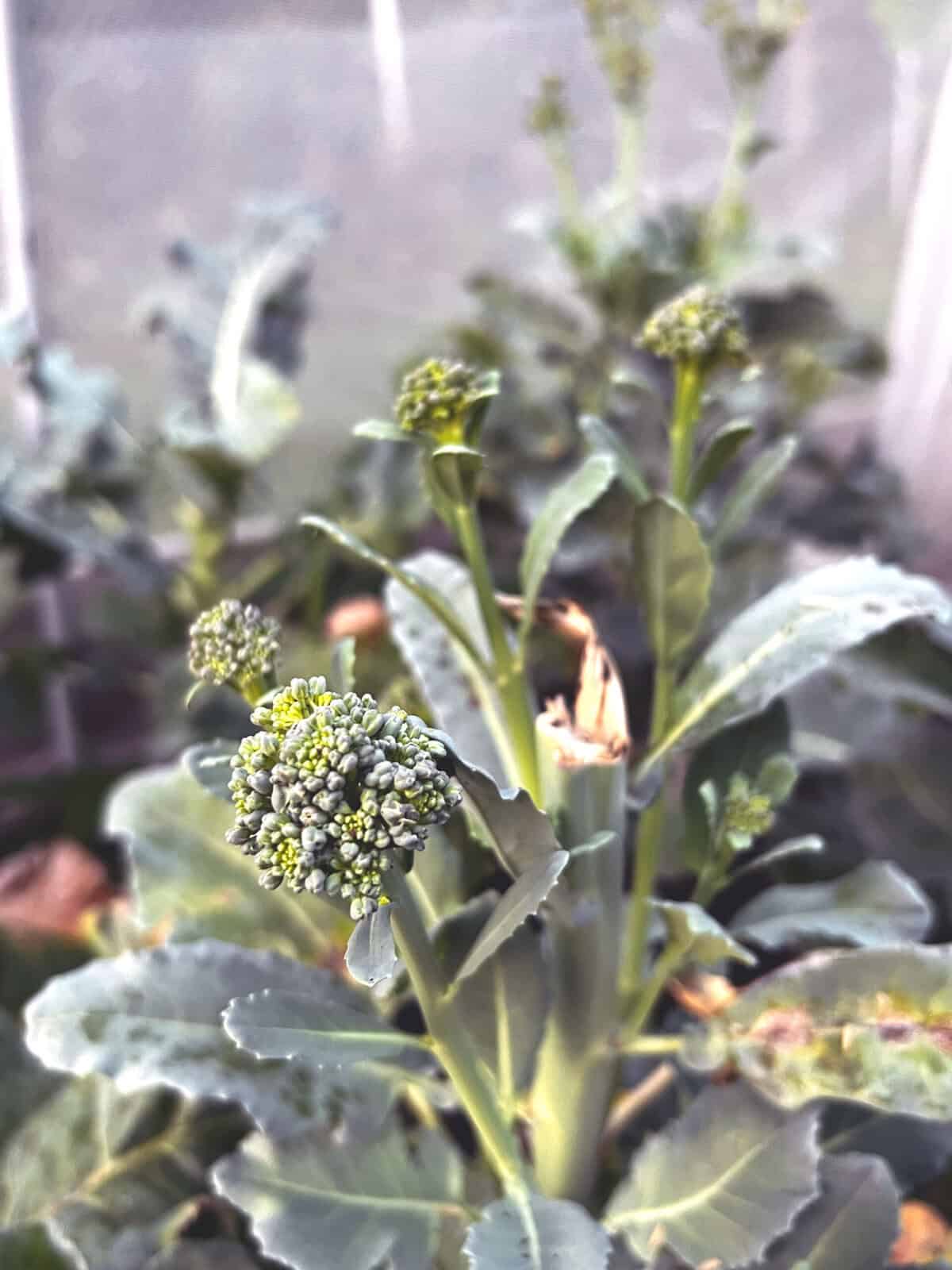
Broccoli TIP - Broccoli will also do the same thing. Just cut the large head on the top of the broccoli stalk when it's ready. Keep the stalk of the plant in tact just removing the head. The broccoli will continue to put out smaller broccoli florets from the leaf nodes along the stem.
Tip #14 - Make things convenient & comfortable
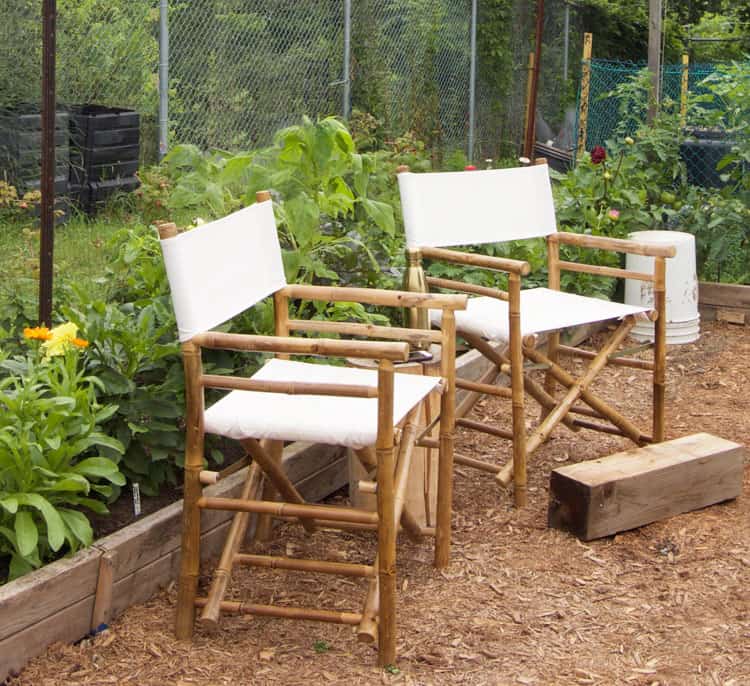
Keep a chair in the garden so you can sit on something civilized as opposed to the dirt. Or a snake. ALSO I keep overturned buckets around the garden so when I'm weeding I'm never far from a bucket to throw the weeds or rocks into. They them get dumped onto the compost pile.

I also eliminated all compost bins in my garden because they aren't convenient. Instead I keep a huge open pile of compost that I can easy add to, remove from and turn.
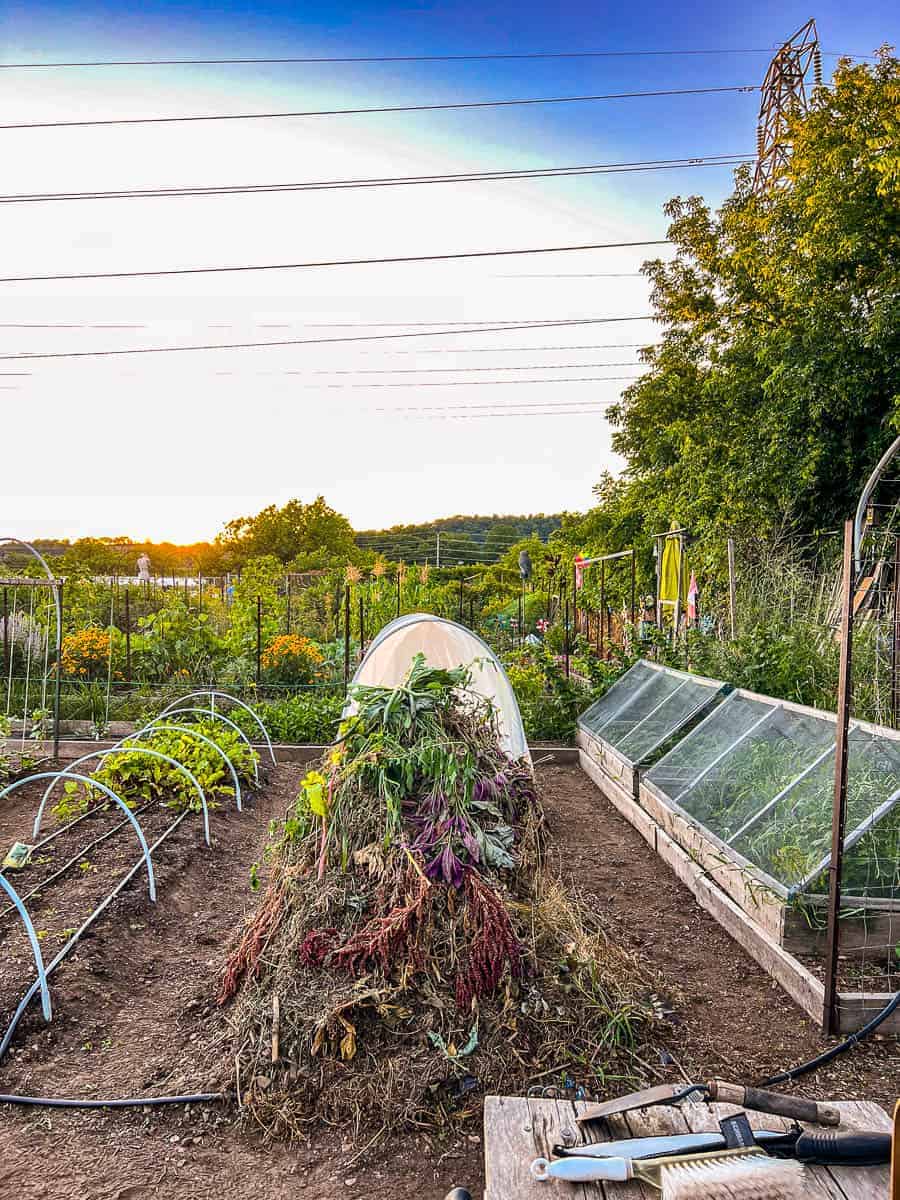
She's not pretty but she produces beautiful compost.
Tip #15 - Rabbits, Raccoons & Deer
The best way to keep rabbits out of a garden is to dig heavy metal fencing 6" or so into the ground around your garden. Rabbits will dig but generally not that deep. They'll chew but generally not through heavy metal.
The best way to keep raccoons out is with flimsy fencing. Building a sturdy tall fence will do nothing other than give the raccoons something sturdy to climb. Flimsy and lightweight is hard to climb.
So the perfect fence is one that has a base of hardware cloth dug at least 6" into the soil around the bottom, with 6' high loosely hung deer netting or hardware cloth on top.
Note: Deer netting is inexpensive and easy to work with but will rip over time and birds and snakes can get caught in it. Hardware cloth is really expensive to surround a garden with but it will last a long time and nothing will get caught in it.
Tip #16 - Snakes
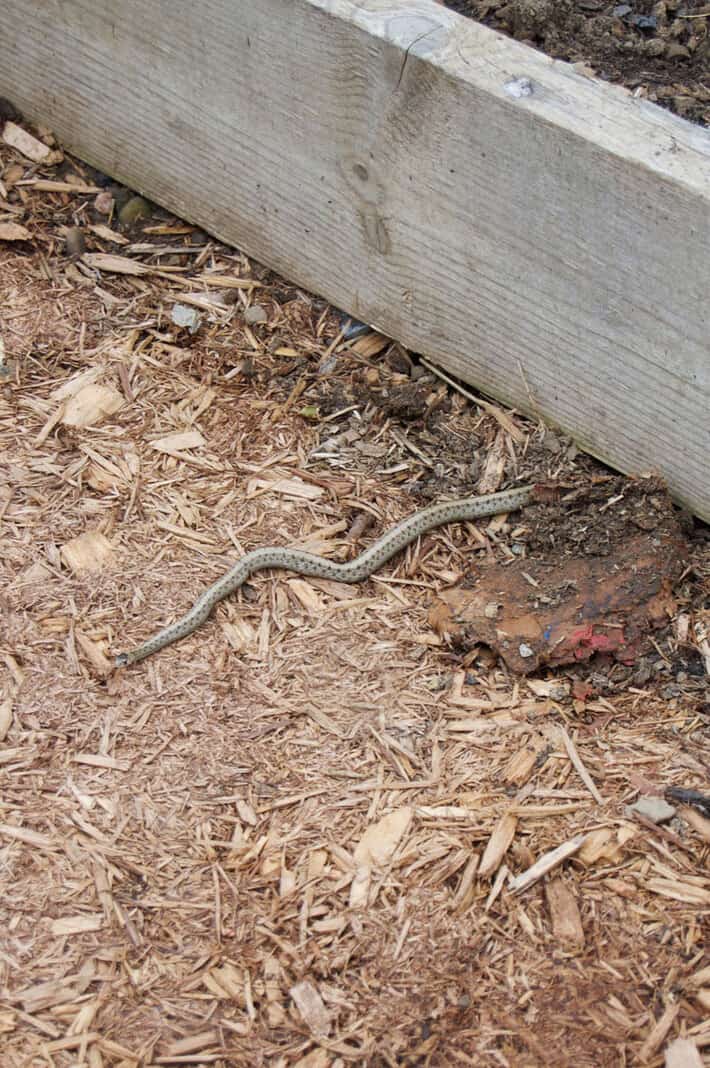
If you aren't terrified of them, you should time-share your garden with snakes. Why?
Snakes will scare mice, voles and other rodents away from your garden plus they eat bugs. Also if there's anyone you don't want visiting you in your garden, having a plot full of snakes is the most discrete way of making sure they never show up.
To attract snakes to your garden leave piles of wood around. You can see this one coming out from underneath the raised bed. They love to hide in the cracks of stacked wood and sun themselves on top. They also love to live in compost piles.
Tip #17 - Work Surface
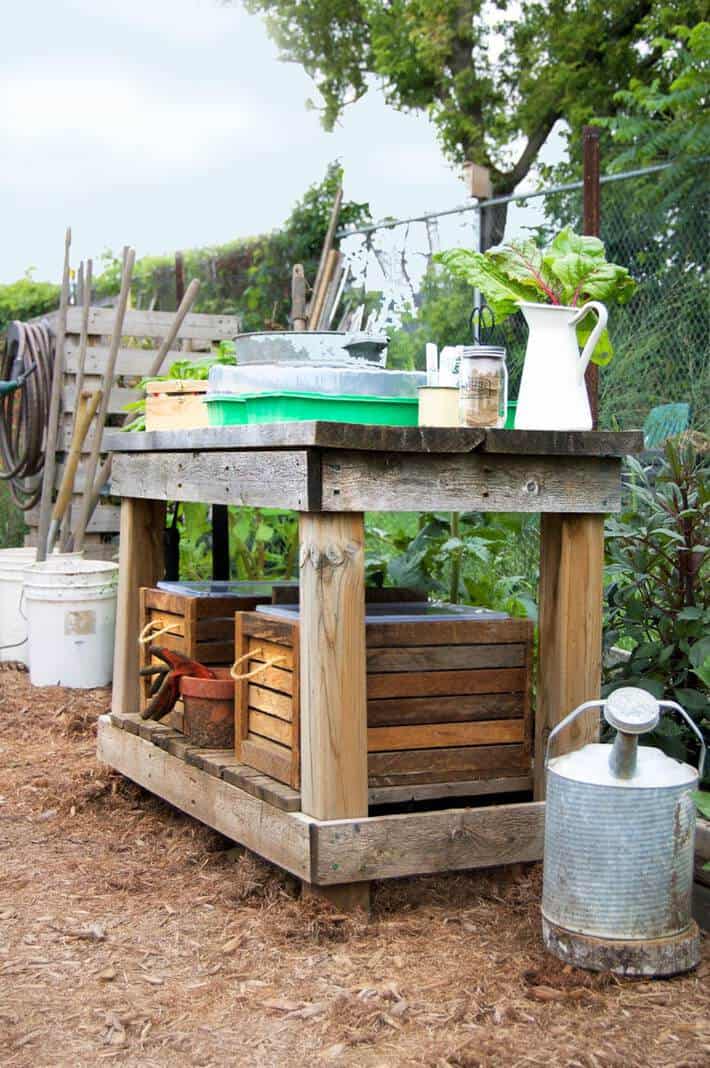
You need somewhere to put stuff. Gardening requires stuff and if your garden isn't a few steps away from your shed then you realllyyyy need somewhere to put stuff. What stuff?
- Seedlings
- Harvested vegetables
- Tools can lean against it
- Water bottle/coffee
I made this garden table out of scraps of wood and donated lumber. AS of 2025 it's in its 9th year and the top is now rotting. Everything else is good so I can just replace the two top boards.
Tip #18 - Keep planting
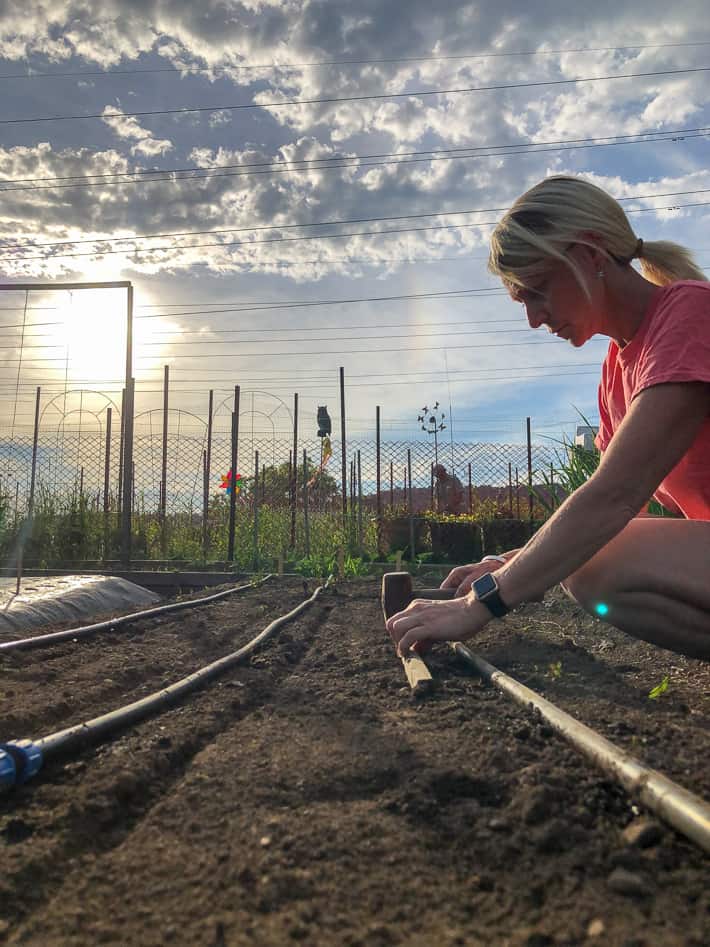
You can keep planting a lot of seeds throughout the season to make sure you have a continuous crop.
When you pull a crop out because it's done (garlic in mid July for instance) you're left with an empty bed. Plant something in it right away so the bed doesn't go to waste and doesn't become a massive bed of weeds.
Carrots, lettuce, beans, onions, spinach, radishes, zucchini & cucumbers are all things you can reseed if they fail the first time or as a succession planting.
In 2024 I planted out carrots and beets seedlings on August 5th. By the end of September I had a massive harvest of carrots. The beet harvest was so/so.
Tip #19 - STRAWberries
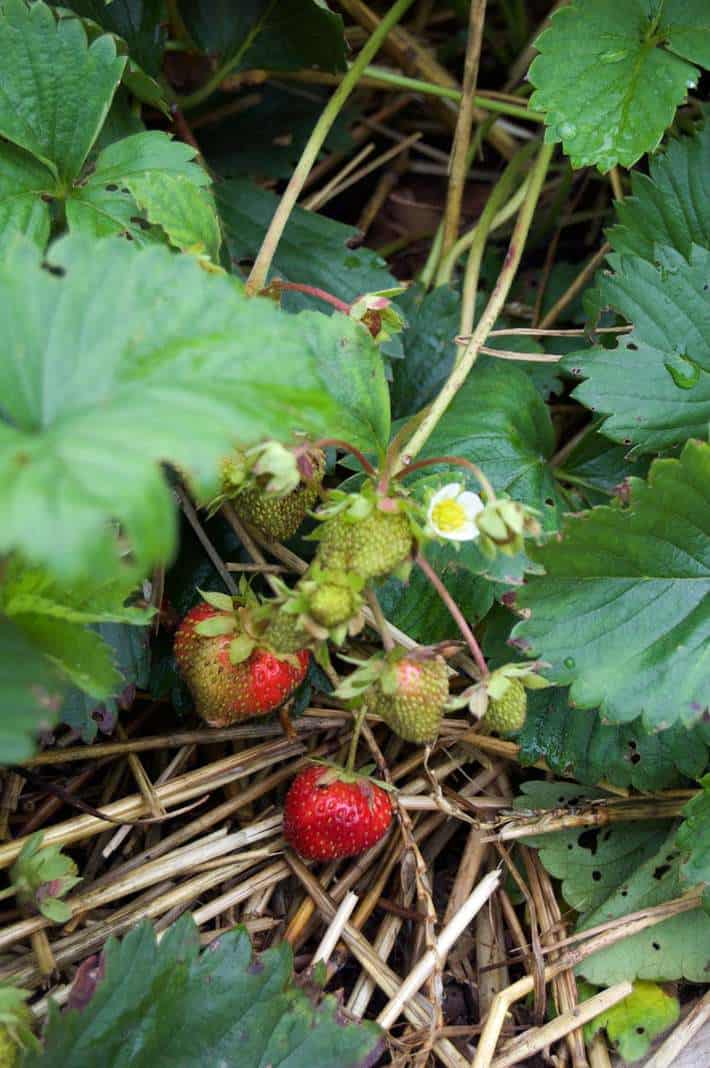
There's a reason they're called "straw" berries. Put a layer of straw underneath your strawberry plants to help keep dirt dwelling insects and moisture off of the berries. Your berries will rot less quickly and never have any dirt or guck on them. You'll be able to pick them clean off of the plant and pop them right in your mouth.
NOTE: Straw can also be a happy haven for slugs, so watch for them and act appropriately with a Slug Chug.
If you're in the US you can use Sluggo which apparently is some fantastic organic slug killer that we can't get in Canada. I haven't looked into it too much.
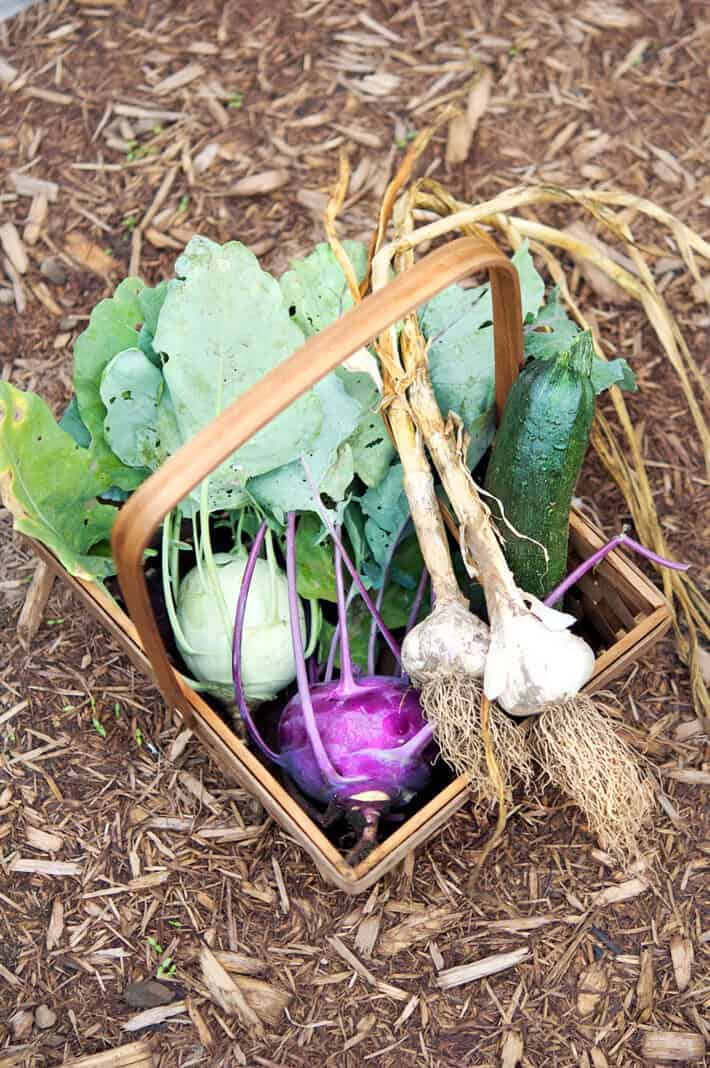
No tip here. Just a pretty picture to entice you into growing your own vegetables if you don't already. Green and purple kohlrabi, fresh pulled garlic and the ubiquitous zucchini.
Tip #20 - Bed Size
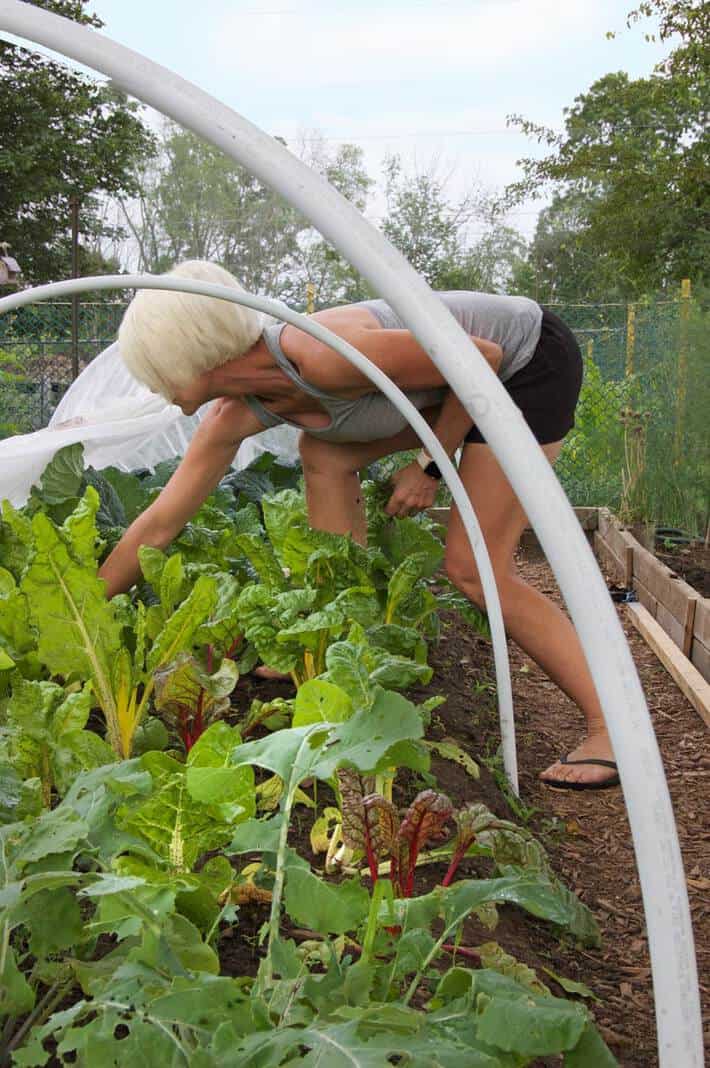
Garden beds are typically 4' wide but if that's too wide for you and your short little freak-show arms, then do them 3'6". When designing your garden make sure it fits YOU.
Also, try to have at least one path that's wide enough for a wheelbarrow if you plan to use one and make sure paths between the beds are big enough to walk and kneel in. You don't need much more than that but you do need room to walk, turn around and work.
I keep paths the width of my 18" rake, which means I just need to do one swipe with the rake to clear or clean the path.
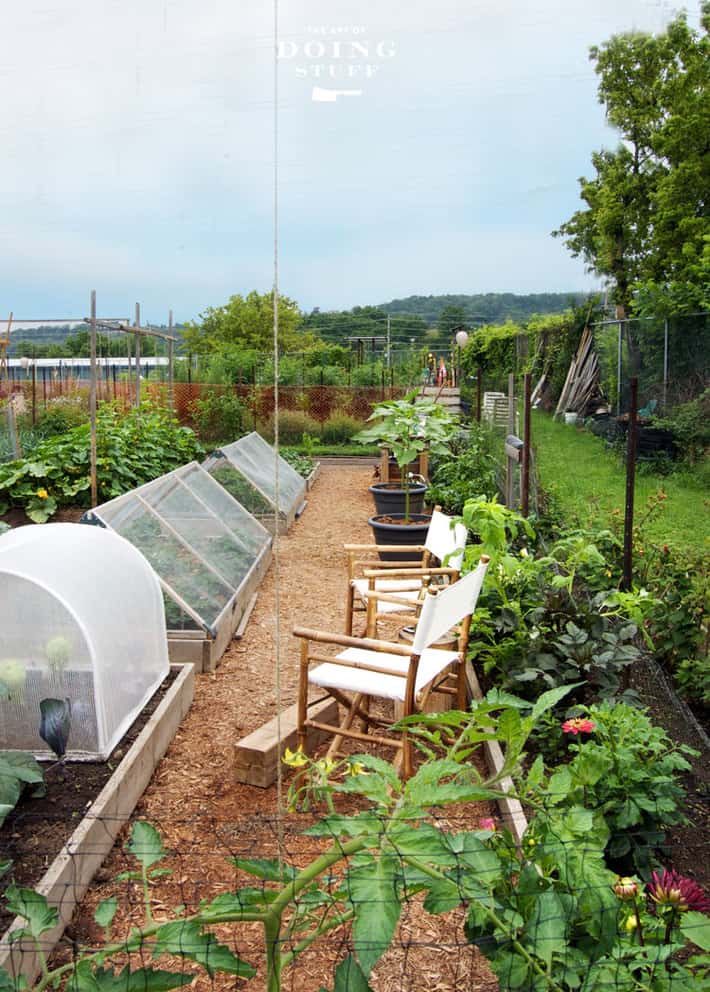
If you really love gardening then take the time to make your garden nice and grow what you like. Or what your friends and family like. Make it a place that's fun to be as opposed to a place you resent being it. It may take a few months of gardeners rage and resentment before you get to the "fun" place but as long as you eventually get there you'll be able to work through the rage.
Bonus Tip - Don't forget the pretty
Europeans have understood the beauty of vegetable gardens for centuries. Potager type gardens evolve outside the kitchen doors of homes in England, France and Italy. There's a beauty in growing your own food and your garden can reflect that.
Keep it simple, keep it weeded and keep it alive. Also ... keep the back of it full of flowers. When all else fails you'll have your zinnia to look at.
Let's end today with a knock knock joke.
Knock knock.
Who's there?
Just some old ho.
Perfect. I have a bed right here for you.


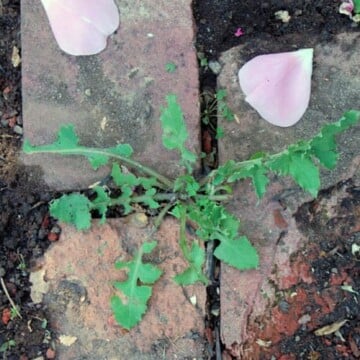


pubg
YOUR GARDEN IS BEAUTIFUL . THANKS
pubg
I give a lot of food away to … well almost everyone from food banks to friends. :) Plus the majority of what I grow is stuff for me to store and use all winter like squash, potatoes, Your garden is beautiful and a vivid reminder of how much work a garden is but, oh so rewarding.
Tim
I'm a newbie for doing the garden. Which season should I plant trees for fast growth?
Barb
I'm most interested in how you keep tree roots out. I have vicious Aus tree (planted on ranches to grow quickly) roots that have steadily been invading and consuming the water and nutrients in all of my garden beds from the little forest a previous homeowner planted 10 meters away. I am now suffering to tear out and relocate the beds. The roots grew through plywood and layers of landscape fabric. Hoping a 2 cinderblock deep bed on landscape fabric with lots of old mulch at the base will work. Your strategies?
Karen
Hi Barb. Tree roots can be awful! They steal nutrients like you say and interfere with the beds. There's nothing you can do other than move the beds to where there aren't any. Tree roots are ridiculously strong being that their only job in life is to stretch out looking for water and food. They can lift an entire house off of its foundation so really the only absolute option is to move the beds to where they're as far away from trees as possible. :/ ~ karen!
Heather
I'm very late to this post but I loved it and wanted to let you know. Thanks, so much! Just moved to a place where I can have a lovely, big veggie garden and I can't wait to start. I've got a tarp laid out on the grass and I'll be covering the area in composted manure so it'll be all ready for no-dig planting in the spring. Your blog is always a pleasure, and the only one I subscribe to. Thanks, Karen!
Karen
Thanks Heather! And good luck with your garden. Let the planning begin! ~ karen
Jo Cedergreen
That is funny! Thanks....now, I have to go look up 'Honeynut.' The mystery continues, then. (Perhaps you planted some nasty-smelling-to-vine borers flower nearby? Petunias? Marigolds?) That same author mentioned that borers will also lay eggs on the underside of leaves and leaf stems, which is why he proposed covering the main vine with soil (!?) to encourage rooting (and giving protection). His thinking is that if a borer does get in, the entire plant won't die because the vine has rooted 'downstream.' Sounds good in theory.
Thank you again, Karen, for sharing yourself. Reading your 'stuff' is like being handed a bowl of ice cream smothered in hot fudge sauce. I mean, I had tears streaming down my face as I read your hysterical letter to Idris Elba!
Karen
Yep, burying the vine is helpful. It's actually Squash bugs that lay on the underside of the leaves. They're a golden coloured egg and they lay in sort of a triangle pattern. You can just rip that portion of the leaf off to get rid of the eggs. Or. You can just buy squash at the grocery store and call it a day. ;) ~ karen!
Jo Cedergreen
Just read through all these tips for the second time - so helpful! Poured over all the photos, again, too. Amazing. You puzzled over why your Butternut went unscathed by the Sq. Vine Borer, which also made me curious. It turns out that Butternut belongs to a certain squash 'family' with particularly tough vines. Also, in the same article I found this:
"Squash vine borer moths are highly attracted to the color yellow. Many gardeners have luck trapping and drowning them by placing a yellow bowl full of water in the garden... This method isn’t 100% effective but its a good way to control the moth’s populations and determine when and if the moths are out. In our area, we have two waves of moths: one in late spring/early summer; the second in August."
Might work, but, then, if the water isn't changed regularly it might just turn into a big playground for baby mosquitoes.
Karen
HI Jo! You're going to find this funny I bet. I didn't grow Butternut Squash, I grew Honeynut, lol. Similar name but different squash. :) I think this year for squash vine borer i'm going to *finally* remember to cover the stems with plastic pipe. :) It's a trick that works if you remember to do it! ~ karen
Chrissy D
My garden is hideous! We moved in last July and the previous owners did nothing to it - it was FULL of 5' weeds. Thistles of every variety, pig weed and whatever weeds grow here in Mn.
How do I get it to a point that I can do the no dig, no till method?
Hubby's idea was to plant rows wide enough to get the tiller down - which is great, but weeds obviously just pop up IN the rows.
I have been telling him NEXT year we need to get this under control - we haven't enjoyed much of anything out of our garden this year because it's overgrown. The tomato plants are like shrubs, the cucumbers and squash and pumpkins have gone crazy ... OH MY! :) (I won't even mention what the weeds are like)
celeste
This garden is truly a work of art. I wish my farmer father was still alive because he would have nodded in approval and said, "That is how a garden should look" and you wouldn't know that that was the highest praise he could ever give. It truly looks like a European garden because it is so tidy and organized and has chairs and everything else that might be needed.
I'm hanging around in case you take up landscaping because I'm going to take notes. We had to give up on vegetables and fruits because we have DEER, dozens and dozens of deer that can easily jump anything less than a 10 foot fence.
Thank you again for inspiration and beauty profound!
Karen
Thanks for the comment Celeste. I've often wished my own father were alive to have seen it. :) ~ karen
Benjamin
OMG, Gurl. Don't you ever work? You always galavanting around in flip-flops and booty shorts. Folded paper hat on your head sitting out front of the dollar store and rummaging around in the dirt.... hot mess !!
MartiJ
Why can't I find that reply to my comment that I wanted to reply to? Very odd. Did you hide it?
I turned off the alarms, turned on the lights and went out digging around to find the fennel's tags. The tag says Foeniculum vulgare, which is the herb, but there is no way that fennel is 3-5 ft tall. And the photo on the tag clearly shows the fennel-vegetable with the big, tasty bulb that I long for... although somewhat different leaves.
So I'm confused. It's my first year. I bet next year, I buy a lovely packet of seeds and grow a whole raft of fennel in that silly window box that someone gave me when they moved away.
Come on, Karen... you want to grow some, too. The bulb is amazing in salads. And it's ever so much more fun when I follow your lead on my garden.
Karen
:) I've grown both fennels. The bulb and the other (just fronds really). The bulb fennel is always called "Florence Fennel". I'm not sure that it goes by any other name or variety. Maybe just buy fennel this year. ;) ~ karen!
MartiJ
I'm going to have to buy. Because as is, I'm going to be totally bummed. I will pull it up and see what is down there. I haven't seen any sign of seeds or anything yet. It got in late (bought it as it was about to be tossed from a nursery in June) so it was just an odd bit.
But as is, I really only know how to eat the bulb.
It's ok... that trained tomato plant will be the gift that keeps on giving through October...
MartiJ
Great list! Really, really great list! Thanks for all the encouragement. My tomato plants are outside right now, eating voraciously and I swear one of those beefsteak tomatoes doubled in size daily, this past week. It was a ton of fun to watch.
I am still hoping you will come up with advice on fennel. I have no idea when to pick, but... I guess I will learn. And if all else fails, I can sit between Theodora the Avocado Tree and Archie, the Barbecue Rosemary and be quiet happy.
Karen
I just remembered that you fennel (if it's bulb fennel) will bolt so um ... pick it before then, lol? ~ karen!
Melissa Keyser
Your community garden posts always leave me speechless simply because of the SIZE! Here in California, a large plot is a 10x10 section (and usually a 5 year waiting list).
Really looking forward to the triangle tent tutorial! I used electrical conduit curved with a pipe bender then just shoved in the ground, but yours look much nicer!
Karen
The size of these plots (I own 2 plots) isn't normal around here either Melissa. Most community gardens have something more similar to what you're describing. This particular community garden has been an active, organic, community garden for over 30 years so we benefit from that. Gardeners have a limit on how many plots they can rent (2 being the limit) so no one ends up just renting the entire 50 or so plots, lol. ~ karen!
JulieD
Beautiful garden, Karen, so well done!! A vegetable garden is one of the most beautiful things in the world, in my opinion. Great post, and tips! I'll be using the carrot sprouting one for sure, and soon. Thanks!
Carol
Wow! Great garden, Karen. So neat and tidy and productive, and large! Good job of turning those two plots into MegaGarden.
Danielle
Amazing!
Do you leave your row covers on for the whole season or just when the plants are young?
Barb
There is nothing more to say about your green thumb that hasn't already been said!
You have one lovely garden!
Karen I'm living in PEI & would love to get some milkweed seeds...I don't even know if they would grow here but id like to try as I'm really interested in the podsthey produce
Can you help me out?
Barb
Karen
Hi Barb! I just did a quick Google search and apparently Swamp Milkweed as opposed to common milkweed is what's native to P.E.I. so you should try to source some of those seeds out locally if you can. The same search showed that PEI was asking residents to plant milkweed to help bring the Monarchs back to PEI and so many people helped and participated that a more recent article (this year or last) said it had been successful. :) So get looking for swamp milkweed! ~ karen
Leslie
Karen, your garden is incredible. Thanks for the beautiful photos and tips!
Question - what is your current watering system like? I have a 20x30 fenced in area with about 15 raised beds that I water manually. I have been considering installing a system but in a way prefer to water each bed myself in the early morning instead. I don't know if installing some kind of system would limit my ability to move things around in the garden in the future. Thoughts?
Karen
Hi Leslie. I'm actually just installing my drip system this week. I don't think it would limit moving things in the future, because you can also move the drip system, but yes, you basically build it into your garden to fit your beds. 2-3 tubes per bed running the length of them. I can't wait to install it because it takes too much time to hand water and if I water with a sprinkler then I can't work in the garden while I'm watering. It occurred to me with a drip system I'll be able to work right in the garden *while* I'm watering it because it's just seeping into the ground as opposed to spraying all over, so I'll save a ton of time. :) There are one or two parts you have to disassemble in the fall and you flush the lines and then that's it I think. I'm doing to do a whole post on how to install it in a couple of weeks. ~ karen!
Linda from Illinois
Karen, I just have to say you are the best! I love your garden, I love your ideas, you inspire me, and make everything beautiful.
Elen G
Everything looks great, Karen, especially the.... snake! :-)